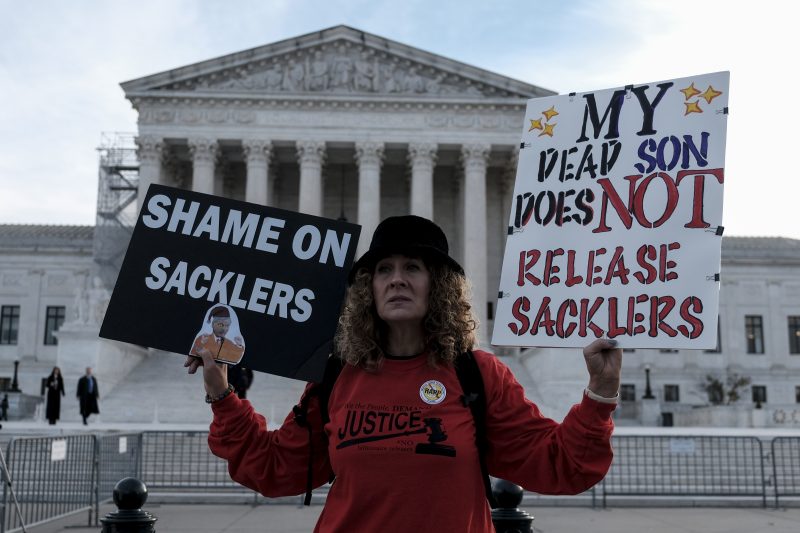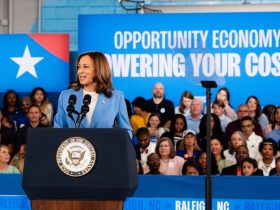The Supreme Court on Monday seemed torn about both the merits and the legality of a proposed Purdue Pharma bankruptcy plan that would allocate billions of dollars to help ease the nation’s opioid crisis, but also shield the family that owns the company from future lawsuits.
Justices across the ideological spectrum asked tough questions of lawyers from the Justice Department, which opposes the plan, and attorneys for Purdue and the vast number of parties that agreed to the deal — seeing it as the best hope of ending years of legal disputes and recovering at least a portion of their claims against Purdue and its owners, the Sackler family.
Those parties say unraveling the settlement plan would leave some victims with nothing.
“Forget a better deal — there is no other deal,” said Washington lawyer Pratik Shah, who represents the interests of states, hospitals, tribes, insurance companies, individual victims and other creditors.
But Curtis E. Gannon, representing the Justice Department, said that claim already has been proven untrue. After some states and individuals objected to a previous version of the plan, he said, the Sackler family ponied up more cash, increasing their contributions from more than $4 billion to about $6 billion, to be paid over nearly two decades.
Gannon said another settlement could be worked out that doesn’t necessarily involve releases or bankruptcy: “We do hope there is another deal at the end of this.”
Purdue declared bankruptcy in 2019, as it faced thousands of lawsuits and allegations that the company helped fuel the opioid crisis by the marketing of its blockbuster painkiller OxyContin. But members of the Sackler family did not themselves file for bankruptcy.
The legal issue before the court is whether, according to federal bankruptcy laws, the Sacklers can be spared from future opioid-related litigation by those who do not consent to give up their rights to sue.
A panel of the U.S. Court of Appeals for the 2nd Circuit said yes, citing two provisions of the bankruptcy code.
One says a bankruptcy court “may issue any order, process, or judgment that is necessary or appropriate to carry out the provisions of” the law. The other says a plan may “include any other appropriate provision not inconsistent with the applicable provisions of” the code.
The appeals court interpreted that to mean a bankruptcy court could approve provisions not expressly forbidden by the code. The Supreme Court in August put the deal on hold to consider the 2nd Circuit’s ruling.
On Monday, Justice Brett M. Kavanaugh seemed to agree with the appeals court, saying “30 years of bankruptcy practice” allows courts broad leeway to determine the best outcome in complicated reorganization cases.
“I think what the opioid victims and their families are saying is you, the federal government, with no stake in this at all, are coming in and telling the families, no, we’re not going to give you … prompt payment for what’s happened to your family,” Kavanaugh said.
Justice Elena Kagan also stressed the pragmatic aspects of the deal, noting that overwhelming majorities of those victims who voted on the plan approved it and saying that under the government’s view, one “nut-case” objector could sink a such a plan.
“Among people who have no love for the Sacklers, among people who think that the Sacklers are pretty much the worst people on earth, they’ve negotiated a deal which they think is the best that they can get,” Kagan said.
The closely watched bankruptcy fight is part of a national reckoning over the role of businesses in the unprecedented public health crisis.
Prescription pain pills from many manufacturers flooded the country in the 2000s, addicting countless Americans and sparking a dramatic rise in overdose deaths. As companies such as Purdue came under increasing scrutiny, fewer doctors began prescribing opioids for pain — leading users to turn to cheap street heroin, and eventually fentanyl manufactured in clandestine labs in Mexico. Overdose deaths from all drugs have topped 100,000 in each of the past two years, according to the Centers for Disease Control and Prevention.
States, local governments, Native American tribes, hospitals, victims and others have sued opioid manufacturers, drug distribution companies, retail pharmacy chains and others. The complex litigation has resulted in more than $50 billion in settlements with states, aimed at helping them ease the crisis.
As part of its bankruptcy reorganization, Purdue Pharma agreed to settle the lawsuits it faced, in a deal valued by the company at $10 billion.
According to the plan, members of the Sackler family would give up ownership of the company, which would become a public trust overseen by an independent board that would steer profits to addressing the crisis. The agreement also established the release of a trove of more than 30 million documents, offering a deeper glimpse at Purdue Pharma and the Sackler family’s marketing of OxyContin.
In 2021, a New York bankruptcy judge approved the deal, which called the Sacklers to contribute up to $4 billion, while shielding family members from future lawsuits. Nine states and the U.S. Trustee objected, although the states dropped those objections after the Sacklers agreed to pay up to $6 billion over 18 years.
U.S. District Judge Colleen McMahon of New York rejected the plan, saying bankruptcy code did not allow for non-debtor releases. But the 2nd Circuit overturned that, setting the stage for the Supreme Court to step in.
In response to the concerns expressed by Kavanaugh and Kagan about the federal government’s role in the case, Gannon said the Justice Department trustee is required to ensure courts don’t strip the rights of people who have not agreed to forgo lawsuits against the Sacklers.
“It’s appropriate for us as a watchdog for the bankruptcy system to say that the court can’t exceed its statutory authority here, and it can’t simply redistribute others’ private property rights because we think that that’s the best deal available and it would serve the greatest good for the greatest number,” he said.
As a practical matter, Gannon added, he doubted the company and its owners would blow up the deal when so many have already agreed to it, even if the court says the agreement cannot terminate the rights of others to sue.
“The Sacklers are saying that they want global peace, but I don’t think that that means that they wouldn’t pay a lot for 97.5 percent peace,” Gannon said.
Other justices noted that some regional appeals courts do not allow plans that terminate, without their consent, the rights of alleged victims to sue parties who are not technically part of the bankruptcy proceedings. And Justice Ketanji Brown Jackson said the possibility of holdouts does not preclude the Sacklers from giving money to those who agree to participate in the settlement.
It was not right to put a possible dissolution of the deal at “the feet of the one nut-case holdout, as Justice Kagan puts it,” she said. “They could still fund the victims who do consent. And so it’s not the holdouts. It’s the Sacklers’ insistence on getting releases from every single person that’s causing this problem, correct?” she asked Gannon.
Jackson said the prohibition on terminating the rights of other alleged victims should be especially true in a case such as this one, where the Sacklers took money out of Purdue and put it in offshore accounts, reducing the amount to be gained by creditors suing the company. The Justice Department has said that the Sacklers withdrew more than $10 billion from the company; the family has said nearly half of that sum was paid in mandatory taxes.
Even Kagan, who earlier in the argument seemed to defended the deal, noted that the Sacklers appeared to be seeking the protections of bankruptcy without committing to the process.
“I thought that one of the government’s stronger arguments is this idea that there’s a fundamental bargain in bankruptcy law, which is you get a discharge when you put all your assets on the table to be divided up among your creditors,” Kagan told the lawyer for Purdue, Gregory G. Garre. “And I think everybody thinks that the Sacklers didn’t come anywhere close to doing that.”
But Garre noted that Sackler contribution made the estate much more lucrative than it would have been. He said barring any future opioid-related lawsuits against the family was essential to that deal.
“If the trustee succeeds here, the billions of dollars that the plan allocates for opioid abatement and compensation will evaporate,” Garre said. “Creditors and victims will be left with nothing, and lives literally will be lost. Nothing in the [bankruptcy] code commands that tragic result.”
Shah, the attorney representing the interests of the creditors who agreed to the deal, noted that there is $40 trillion in estimated claims against family members. The idea of the releases came from creditors and victims, he said, as part of a “collective action” aimed at ensuring there was enough settlement money to go around.
It was necessary to “avoid a value-destroying, victim-against-victim race to the courthouse that would result in no recovery for virtually all except the United States,” he said.
The case is Harrington v. Purdue Pharma.








